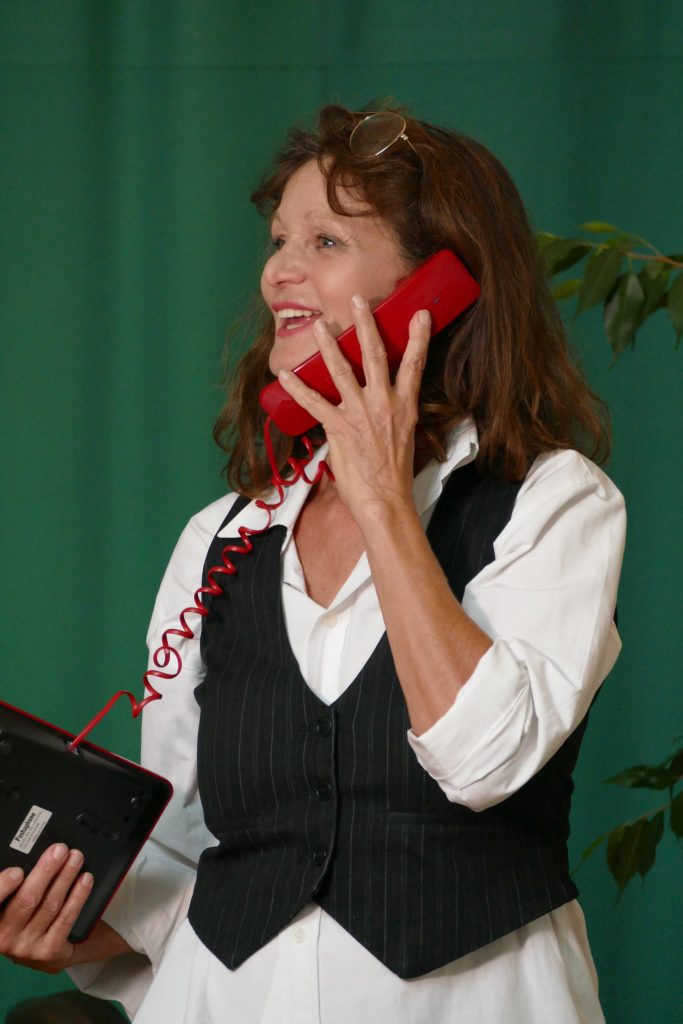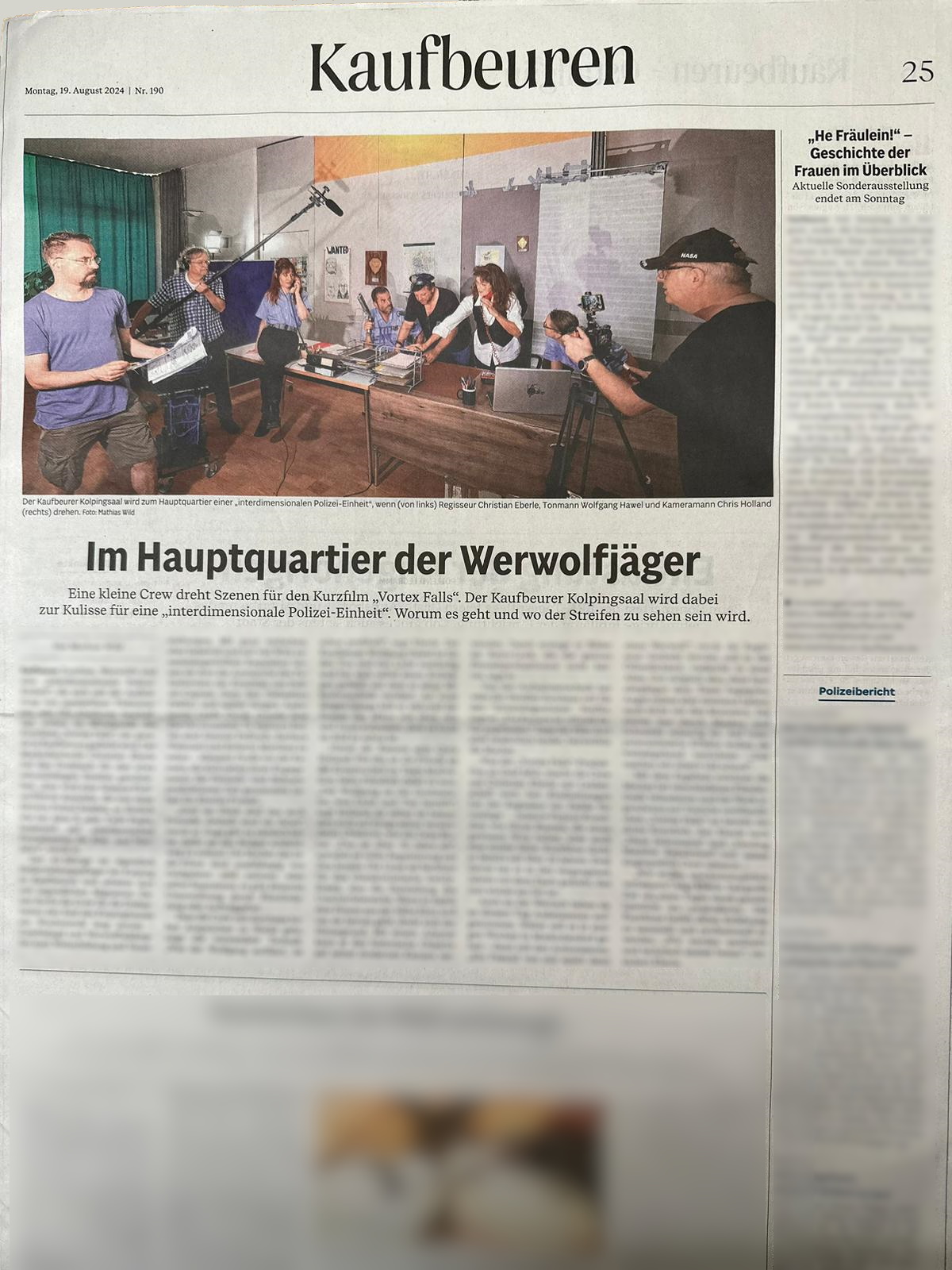
Abstract: In this article, we will explain the ongoing production of the short film VORTEX FALLS and how AI (artificial intelligence) tools are helping us make it. Many people predict the demise of filmmaking because of AI video generators like Sora, but we believe that AI tools can also be of great benefit to low-budget filmmaking.
First, we will briefly explain the film project to give you a better understanding of where and how AI tools support our filmmaking.
What are the highlights of our short filmmaking project Vortex falls?
- Vortex Falls is a science fiction short film of approximately 10 minutes length.
- The cast is made up of professional actors and actresses, some of whom appear in well-known TV series and comedy shows.
- We have a dedicated art director, Katja Vartiainen, who was born in London/United Kingdom and is a Finnish citizen. Katja knows how to pull the right strings to bring together the right creative contributions for an enjoyable team success, and she is our trusted captain through the stormy seas of art. She graduated with a Master of Fine Arts degree from the Marseille School of Fine Arts in France in 2006.
- Maximum use of existing AI tools, no “AI marketing blah blah”, but obvious efficiency improvements right on the line.
- Sony S-Log3 10-bit 4:2:2 video recording allows us creative color grading without compromising quality in post-production, bringing us closer to the potential of RAW recording with affordable video equipment.
- Usage of legendary classic Zeiss lenses which deliver high quality and “characterful” images with beautiful visual properties, modern lenses cannot provide. In this film we use the Carl Zeiss Vario-Sonnar T* 28-85mm classic lens, which was made more than 30 yeras ago, for some key scenes.

Here is an exclusive interview with Christian, producer and director of the independent short film VORTEX FALLS by the crew member Chris
Chris: How did you come up with the VORTEX FALLS script?
Christian: After we did Vending Machine Repairmen and Hans Jedermann I was looking for a new short-project and remembered I wrote Vortex Falls quite a while ago but put it in the proverbial drawer and almost forgot.
Chris: Are there similarities with known science fiction movies?
Christian: The show is heavily inspired by X-Files and Twin Peaks… and the many police procedurals.
Chris: How have the props been chosen?
Christian: Katja Vartiainen, my wife, usually takes care of props and costumes. She build many props herself since she’s a master of fine arts. Costumes we usually buy online, often used or from local flea markets. We love vintage props that are real at the same time. So we love to buy real 1990s telephones on Ebay for example.
Chris: Why was a slow-motion scene shot as a film intro?
Christian: That was a last minute idea also by Katja. I mentioned the evening before filming that there’s a quite long voice over monologue by Sebastian Feicht (Captain Gary Stu Johnson) and that the dolly shot might be too short otherwise. That was a lucky decision since the slow-motion looks amazing.
Chris: Why was the first shooting day in Kaufbeuren?
Christian: We used again the conference room at my workplace since it’s basically (like) a film studio. Also, because it’s really affordable.
Chris: What makes VORTEX FALLS different from other indie shorts?
Christian: I prefer crazy-whacky concepts and do not like shorts that are “dramas shot in a living room” as I like to say. I like bold concepts with interesting costumes – be it worker’s overalls or fictional police uniforms.
Chris: What is the biggest challenge in making this short film?
Christian: The filming of all the police station scenes was tough since it was a really hot day and this can affect the performances and overall energy of everybody involved.
Chris: What makes the difference having professional actors in the film crew?
Christian: It’s like night and day! Professionals barely need any directing and on top of it actively add great ideas and character details.
Chris: What is your next project?
Christian: Maybe Vortex Falls Episode 2 since I love the concept and characters. But I also have – as always – other ideas. And who knows: One day maybe a feature-length project.
Behind-the-Scenes: Film Set Photos
How does our short film production benefit from AI-related technology?
In my humble opinion, independent filmmaking has benefited tremendously from technological advances, especially in the last 2 years. Here are some practical examples of how our short film production is benefiting from new AI-based technology:
- ChatGPT support in script optimization
- HitPaw Video AI and Topaz Video AI do help in saving otherwise de-focused scene shots, if you spend plenty of CPU and GPU processing power “overnight”
- The new dedicated focus AI-processing unit of the Sony a7cii camera easily outperforms manual focus follow gear
- Creation of movie scenes of AI-generated images with Nightcafe AI Art Generator and simple text prompts, applying proper prompt engineering
- Powerful AI capabilities built into Premiere PRO and DaVinci Resolve Studio video editing software enable unprecedented efficiency in post-production, including:
- automatic mapping of audio to video tracks without the traditional film clap board
- removal of unwanted objects in the scene backgrounds
- cleaning of unwanted audio sources like traffic and other background noise
- relight AI feature to optimize the lighting in post production
- SEO-oriented title and content polishing of this short film landing page with ChatGPT, Google Gemini and DeepL
- Topaz Photo AI and Luminar Neo AI help rescue otherwise unusable photos from the film set
Behind-the-Scenes: The Film Crew

Many thanks to all of the 14 people of the film crew, who contributed on the first shooting day in Kaufbeuren, including Ute, Torsten and Rahmatullah.
At the Headquarters of the Werewolf Hunters


Creative coloring potential with Sony S-Log3 10-bit 4:2:2 video recording
The new shot short film VORTEX FALLS of director Christian Eberle uses a SONY S-Log3 camera recording with 10-bit 4:2:2 video in 4K resolution. This allows for extensive color grading in completely different visual directions, without the artifacts of bending.
Check out the slow-motion intro scene in some very distinctive, compelling visual flavors. Get informed about Sony S-Log video recording and Look-Up-Tables / LUT’s here:
S-Log video recording – https://pro.sony/…/technology/s-log
LUTs – https://pro.sony/…/professional-video/look-up-table
The color grading of VORTEX FALLS was performed with DaVinci Resolve Studio version 19beta.
Normal REC.709 color grading with “pop art accent”
Normal REC.709 color grading with “pop art accent”: Standard S-Log3 to REC.709 coloring with some increased saturation and luminance in colors.
Classic French Noir 1930s – color grading
Classic French Noir 1930s influenced color grading: Black and white coloring in very high contrast with strongly reduced highlights and shadows.
B&W Hitchcock’s Psycho 1960 – color grading
B&W Hitchcock’s Psycho 1960 influenced color grading: Medium lifted highlights and contrast with reduced shadows.
Celluloid Analog Film – color grading
Celluloid Analog Film influenced color grading: embracing the classic analog film era with warm colors and reduced contrasts.
The Royal Tenenbaums 2001 – color grading
The Royal Tenenbaums 2001 influenced color grading: mostly warm tones with quite saturated red colors, reduced highlights and rather natural contrast levels.
Have a look at previous short films with the same director and film crew
Short film HANS JEDERMANN inspired by the visual look of the Netflix sensation ‘The Queen’s Gambit’
More information about the famous Carl Zeiss Vario-Sonnar 28-85mm f3.3-4 classic lens which was used for some scenes in the short film VORTEX FALLS
Best Zeiss Zoom Lens? Review of the Carl Zeiss Vario-Sonnar T* 28-85mm f/3.3-4
Does this page have an Internet short link?
Yes, you can use the short link https://vortex.swiss-1.ch to reach this VORTEX FALLS landingpage.
Don’t hesitate to leave a comment below
Your comments are highly valued. Please note that comments undergo manual verification to prevent spam, which may cause a delay in their appearance.
What are the key aspects of Christian’s approach to filmmaking, particularly in terms of concept, actors, and challenges faced during the production of *Vortex Falls*?
Regard Teknologi Telekomunikasi Indonesia
In my view, clearly the script